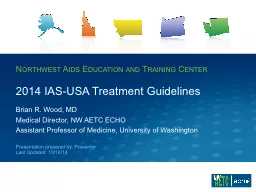/


Brian R Wood MD Medical Director NW AETC ECHO Assistant Professor of Medicine University of Washington Presentation prepared by Presenter Last Updated 101614 International Antiviral SocietyUSA Guidelines ID: 760191
Download Presentation The PPT/PDF document "2014 IAS-USA Treatment Guidelines" is the property of its rightful owner. Permission is granted to download and print the materials on this web site for personal, non-commercial use only, and to display it on your personal computer provided you do not modify the materials and that you retain all copyright notices contained in the materials. By downloading content from our website, you accept the terms of this agreement.
Slide1
2014 IAS-USA Treatment Guidelines
Brian R. Wood, MDMedical Director, NW AETC ECHOAssistant Professor of Medicine, University of Washington
Presentation prepared by:
Presenter
Last Updated:
10/16/14
Slide2International Antiviral Society-USA Guidelines Updated July 2014
Prevention Guidelines – Dr. Marrazzo will discuss 11/6/14Treatment Guidelines
Slide3Rating Scale
Strength of Recommendations:
A: Strong support
B: Moderate support
C: Limited support
Quality of Evidence:
I
a:
>
1 RCTs published in peer-reviewed literature
Ib:
>
1 RCTs presented at peer-reviewed scientific meetings
IIa: non-RCT’s, cohort, or case-control studies published
IIb: non-RCT’s, cohort, or case-control studies presented
III: panel’s analysis of accumulated available evidence
Slide4When to Start
Slide5What to Start: Recommended Initial Regimens
Anchor
BackboneCommentsDolutegravirTenofovir-emtricitabineMay increase serum creatinineDolutegravir^Abacavir-lamivudineAbacavir not inferior to tenofovir at high HIV RNA levels if given with dolutegravirElvitegravir/cobicistat^Tenofovir-emtricitabineMay increase serum creatinine; similar drug interactions as ritonavirRaltegravirTenofovir-emtricitabineRaltegravir twice dailyEfavirenz^Tenofovir-emtricitabineCNS/psych SE’s; no longer contraindicated in pregnancy but avoid in woman of child-bearing potentialEfavirenzAbacavir-lamivudineSame as aboveRilpivirine^Tenofovir-emtricitabineAvoid if HIV RNA >100,000 copies or on PPI; taken with full mealAtazanavir/ritonavirTenofovir-emtricitabineMay cause cholelithiasis/nephrolithiasis; consider H2 blocker/PPI interactionsDarunavir/ritonavirTenofovir-emtricitabineOnce-daily dosing for initial therapy
^
Single tablet regimen (STR) option
Slide6Additional Considerations
Tenofovir: Potential for renal and bone toxicityAbacavir:Associated with cardiovascular events, though data conflictingHLA-B*5701 must be negativeAbacavir/lamivudine:Less efficacious than tenofovir/emtricitabine when given with efavirenz or boosted atazanavir if baseline HIV RNA >100,000
Slide7What to Start: Alternatives
Anchor
Backbone
Comments
Raltegravir
Abacavir-lamivudine
Abacavir not inferior to tenofovir at high HIV RNA levels if given with raltegravir
Nevirapine
2 NRTI’s
Severe hepatotoxicity may occur if CD4 >250 in women
or >400 in men; more severe rash than other NNRTI’s
Rilpivirine
Abacavir-lamivudine
Not recommended if HIV RNA
>100,000 copies
Atazanavir-cobicistat
2 NRTI’s
Atazanavir
levels equivalent with cobicistat or ritonavir
Darunavir-cobicistat
2 NRTI’s
Darunavir levels equivalent with cobicistat or ritonavir
Lopinavir-ritonavir
2 NRTI’s
May be less tolerable and have increased CV
toxicity
Darunavir-ritonavir
Abacavir-lamivudine
Single randomized study available
Darunavir-ritonavir
Raltegravir
Inferior if CD4 <200 or
HIV RNA >100,000
copies
Lopinavir-ritonavir
Raltegravir
Single study
available with significant limitations
Lopinavir-ritonavir
Lamivudine
Single study available with significant limitations
Slide8Estimated Patent Expiration Dates for Branded Antiretrovirals
Year
Antiretrovirals
2012
Zidovudine, lamivudine, stavudine, didanosine, saquinavir, nevirapine
2013
Ritonavir, efavirenz, zidovudine/lamivudine
2016
Abacavir, lopinavir/ritonavir (softgel)
2017
Tenofovir,
ata
zanavir, darunavir
2019
Etravirine, abacavir/lamivudine
2024
Tenofovir/emtricitabine
2025
Raltegravir
2026
Tenofovir/emtricitabine/efavirenz,
tenofovir/emtricitabine/rilpivirine, dolutegravir
Slide9Initiating ART in Special Circumstances
Slide10Initiating in Setting of an Acute OI or Tuberculosis
Slide11ART Monitoring
“There are
insufficient data
to make general recommendations
for
the management of
patients with sustained viremia of 50 to 200 copies
/mL.”